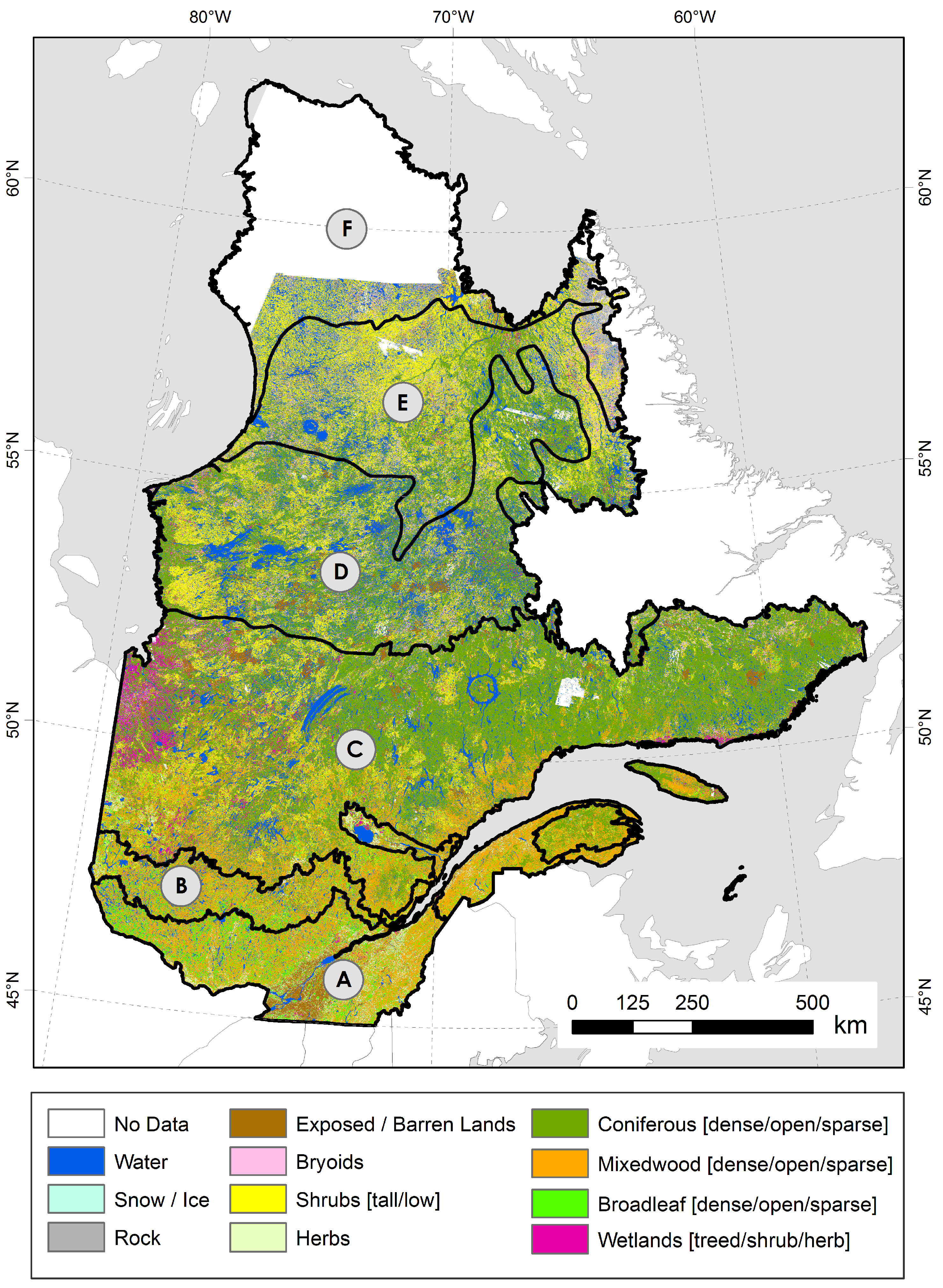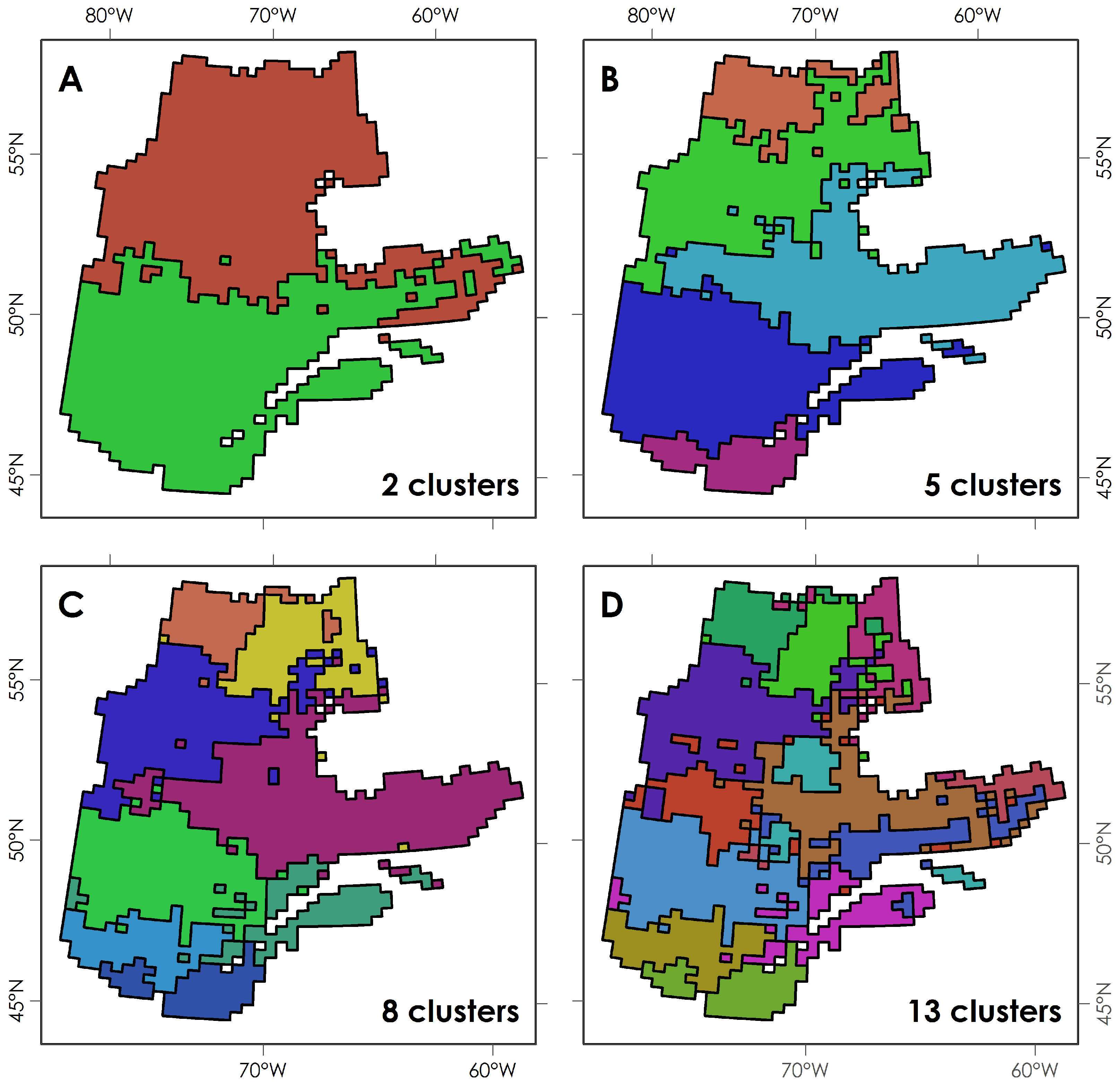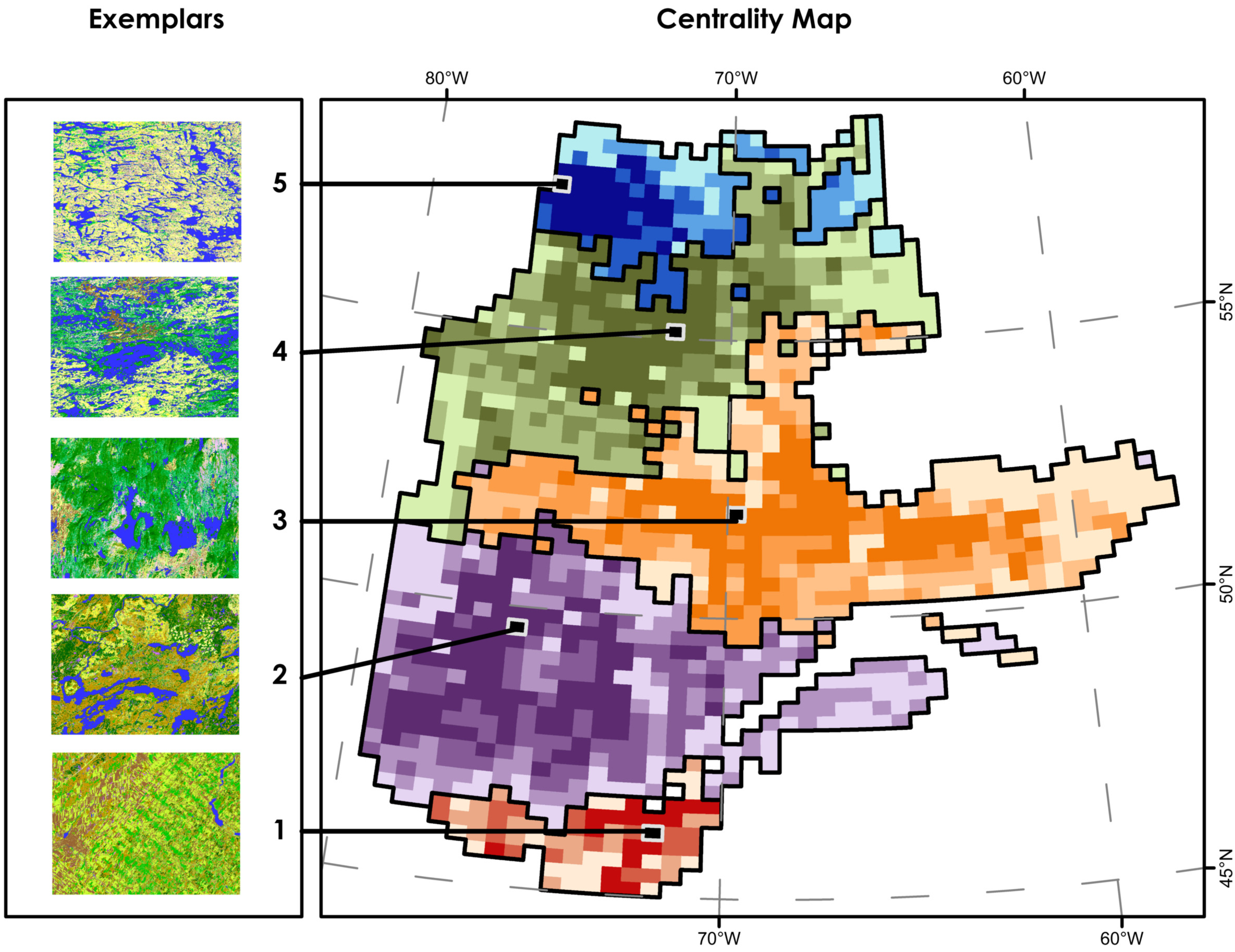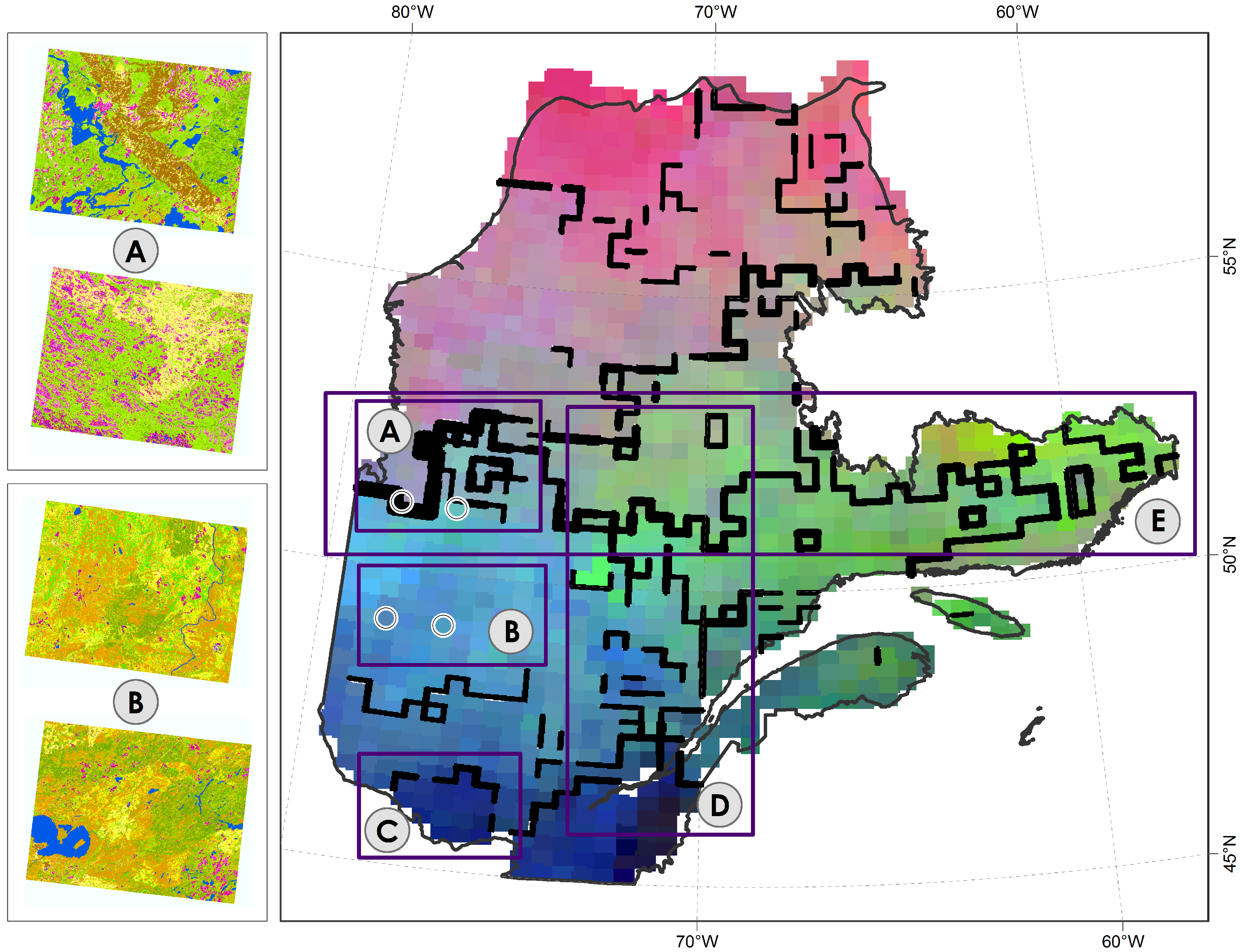Uncovering Dominant Land-Cover Patterns of Quebec: Representative Landscapes, Spatial Clusters, and Fences
Abstract
:1. Introduction
2. Material and Methods
2.1. Study Area

2.2. Land-Cover Data and Landscape Metrics
2.3. Extracting Information from Metric Values: Clustering and Determining Representatives
2.4. Spatial Fences
3. Results
3.1. Composite Image of PCA Values

3.2. Spatial Clusters


3.3. Representative Land-Cover Patterns of Forested Quebec
- “Exemplar 1—pasture lands and broad-leaf forest” (Figure 4, #1) is a landscape dominated by a mixed of pasture-lands (herbs) and croplands (exposed lands), and patches of dense broad-leaf forest. This landscape corresponds to the typical southern Quebec agricultural landscape with its human induced patterns—square shaped patches—rather than natural land cover patterns, which is consistent with Pan et al. [52].
- “Exemplar 2—mixed forest” (Figure 4, #2) is composed of dense mixed-wood and dense coniferous forest, and logging patterns are also very noticeable with networks of square-shaped “shrub” patches linked by thin straight forest roads, human induced patterns such as those from logging, and highly linear patches (roads, power transmission line corridors, rail roads). These patterns match expectations based on previous studies [16,17].
3.4. Spatial Fences

4. Discussion
4.1. Landscape Pattern Information and Clustering
4.2. Representative Landscapes
4.3. Spatial Aspect of Land-Cover Patterns
4.4. Limits of Research and Future Work
5. Conclusions
Acknowledgments
Conflicts of Interest
References
- Olson, D.M.; Dinerstein, E.; Wikramanayake, E.D.; Burgess, N.D.; Powell, G.V.N.; Underwood, E.C.; D’Amico, J.A.; Itoua, I.; Strand, H.E.; Morrison, J.C.; et al. Terrestrial ecoregions of the worlds: A new map of life on Earth. BioScience 2001, 51, 933–938. [Google Scholar] [CrossRef]
- Coops, N.C.; Wulder, M.A.; Iwanicka, D. An environmental domain classification of Canada using earth observation data for biodiversity assessment. Ecol. Inform. 2009, 4, 8–22. [Google Scholar] [CrossRef]
- Robitaille, A.; Saucier, J.P. Paysages Régionaux du Québec Méridional; Les Publications du Québec: Québec, QC, Canada, 1998; p. 213. [Google Scholar]
- Mackey, B.G.; Berry, S.L.; Brown, T. Reconciling approaches to biogeographical regionalization: A systematic and generic framework examined with a case study of the Australian continent. J. Biogeogr. 2008, 35, 213–229. [Google Scholar] [CrossRef]
- Hargrove, W.W.; Hoffman, F.M. Using multivariate clustering to characterize ecoregion borders. Comput. Sci. Eng. 1999, 1, 18–25. [Google Scholar] [CrossRef]
- Loveland, T.R.; Merchant, J.M. Ecoregions and ecoregionalization: Geographical and ecological perspectives. Environ. Manag. 2004, 34, S1–S13. [Google Scholar] [CrossRef]
- Grandmont, K.; Fortier, D.; Cardille, J.A. Multi-Criteria Analysis with Geographic Information Systems in Changing Permafrost Environments: Opportunities and Limits. In Cold Regions Engineering 2012: Sustainable Infrastructure Development in a Changing Cold Environment; Morse, B., Dore, G., Eds.; American Society of Civil Engineers (ASCE): Reston, VA, USA, 2012; pp. 666–675. [Google Scholar]
- Dale, V.H.; Joyce, L.A.; McNulty, S.; Neilson, R.P.; Ayres, M.P.; Flannigan, M.D.; Hanson, P.J.; Irland, L.C.; Lugo, A.E.; Peterson, C.J.; et al. Climate change and forest disturbances. BioScience 2001, 51, 723–734. [Google Scholar] [CrossRef]
- Heikkinen, R.K.; Luoto, M.; Araujo, M.B.; Virkkala, R.; Thuiller, W.; Sykes, M.T. Methods and uncertainties in bioclimatic envelope modelling under climate change. Prog. Phys. Geogr. 2006, 30, 751–777. [Google Scholar] [CrossRef]
- Allen, C.D.; Macalady, A.K.; Chenchouni, H.; Bachelet, D.; McDowell, N.; Vennetier, M.; Kitzberger, T.; Rigling, A.; Breshears, D.D.; Hogg, E.H.; et al. A global overview of drought and heat-induced tree mortality reveals emerging climate change risks for forests. For. Ecol. Manag. 2010, 259, 660–684. [Google Scholar] [CrossRef]
- Millar, C.I.; Stephenson, N.L.; Stephens, S.L. Climate change and forests of the future: Managing in the face of uncertainty. Ecol. Appl. 2007, 17, 2145–2151. [Google Scholar] [CrossRef]
- Bailey, R.G. Identifying ecoregion boundaries. Environ. Manag. 2004, 34, S14–S26. [Google Scholar] [CrossRef]
- Turner, M.G. Landscape ecology: What is the state of the science? Annu. Rev. Ecol. Evol. Syst. 2005, 36, 319–344. [Google Scholar] [CrossRef]
- Turner, M.G.; Gardner, R.H.; O’Neil, R.V. Landscape Ecology in Theory and Practice: Pattern and Process, 1st ed.; Springer-Verlag: New York, NY, USA, 2001; p. 404. [Google Scholar]
- Bergeron, Y.; Gauthier, S.; Kafka, V.; Lefort, P.; Lesieur, D. Natural fire frequency for the eastern Canadian boreal forest: Consequences for sustainable forestry. Can. J. For. Res. 2001, 31, 384–391. [Google Scholar] [CrossRef]
- Boucher, Y.; Arseneault, D.; Sirois, L.; Blais, L. Logging pattern and landscape changes over the last century at the boreal and deciduous forest transition in Eastern Canada. Landsc. Ecol. 2009, 24, 171–184. [Google Scholar] [CrossRef]
- Boucher, Y.; Arseneault, D.; Sirois, L. Logging-induced change (1930–2002) of a preindustrial landscape at the northern range limit of northern hardwoods, eastern Canada. Can. J. For. Res. 2006, 36, 505–517. [Google Scholar] [CrossRef]
- Boucher, Y.; Grondin, P. Impact of logging and natural stand-replacing disturbances on high-elevation boreal landscape dynamics (1950–2005) in eastern Canada. For. Ecol. Manag. 2012, 263, 229–239. [Google Scholar] [CrossRef]
- Lillesand, T.M.; Kiefer, R.W.; Chipman, J.W. Remote Sensing and Image Interpretation, 6th ed.; John Wiley & Sons, Inc.: Hoboken, NJ, USA, 2008; p. 756. [Google Scholar]
- Loveland, T.R.; Reed, B.C.; Brown, J.F.; Ohlen, D.O.; Zhu, Z.; Yang, L.; Merchant, J.W. Development of a global land cover characteristics database and IGBP DISCover from 1 km AVHRR data. Int. J. Remote Sens. 2000, 21, 1303–1330. [Google Scholar] [CrossRef]
- Latifovic, R.; Zhu, Z.L.; Cihlar, J.; Giri, C.; Olthof, I. Land cover mapping of north and central America—Global land cover 2000. Remote Sens. Environ. 2004, 89, 116–127. [Google Scholar] [CrossRef]
- Prince, S.D.; Steininger, M.K. Biophysical stratification of the Amazon basin. Glob. Chang. Biol. 1999, 5, 1–22. [Google Scholar] [CrossRef]
- Chen, G.; Hay, G.J.; St-Onge, B. A GEOBIA framework to estimate forest parameters from lidar transects, Quickbird imagery and machine learning: A case study in Quebec, Canada. Int. J. Appl. Earth Obs. Geoinf. 2012, 15, 28–37. [Google Scholar] [CrossRef]
- Chen, G.; Hay, G.J. An airborne lidar sampling strategy to model forest canopy height from Quickbird imagery and GEOBIA. Remote Sens. Environ. 2011, 115, 1532–1542. [Google Scholar] [CrossRef]
- Hay, G.J.; Blaschke, T. Special issue: Geographic Object-Based Image Analysis (GEOBIA) foreword. Photogramm. Eng. Remote Sens. 2010, 76, 121–122. [Google Scholar]
- Ramankutty, N.; Evan, A.T.; Monfreda, C.; Foley, J.A. Farming the planet: 1. Geographic distribution of global agricultural lands in the year 2000. Glob. Biogeochem. Cycle. 2008. [Google Scholar] [CrossRef]
- Monfreda, C.; Ramankutty, N.; Foley, J.A. Farming the planet: 2. Geographic distribution of crop areas, yields, physiological types, and net primary production in the year 2000. Glob. Biogeochem. Cycle. 2008. [Google Scholar] [CrossRef]
- Girvetz, E.H.; Thorne, J.H.; Berry, A.M.; Jaeger, J.A.G. Integration of landscape fragmentation analysis into regional planning: A statewide multi-scale case study from California, USA. Landsc. Urban Plan. 2008, 86, 205–218. [Google Scholar] [CrossRef]
- Cardille, J.A.; Foley, J.A. Agricultural land-use change in Brazilian Amazonia between 1980 and 1995: Evidence from integrated satellite and census data. Remote Sens. Environ. 2003, 87, 551–562. [Google Scholar] [CrossRef]
- Cardille, J.A.; Foley, J.A.; Costa, M.H. Characterizing patterns of agricultural land use in Amazonia by merging satellite classifications and census data. Glob. Biogeochem. Cycle. 2002. [Google Scholar] [CrossRef]
- Ellis, E.C.; Ramankutty, N. Putting people in the map: Anthropogenic biomes of the world. Front. Ecol. Environ. 2008, 6, 439–447. [Google Scholar] [CrossRef]
- Gustafson, E.J. Quantifying landscape spatial pattern: What is the state of the art? Ecosystems 1998, 1, 143–156. [Google Scholar] [CrossRef]
- Peng, J.; Wang, Y.; Zhang, Y.; Wu, J.; Li, W.; Li, Y. Evaluating the effectiveness of landscape metrics in quantifying spatial patterns. Ecol. Indic. 2010, 10, 217–223. [Google Scholar] [CrossRef]
- Li, H.B.; Wu, J.G. Use and misuse of landscape indices. Landsc. Ecol. 2004, 19, 389–399. [Google Scholar] [CrossRef]
- Kupfer, J.A. National assessments of forest fragmentation in the US. Glob. Environ. Chang. 2006, 16, 73–82. [Google Scholar] [CrossRef]
- Wulder, M.A.; White, J.C.; Han, T.; Coops, N.C.; Cardille, J.A.; Holland, T.; Grills, D. Monitoring Canada’s forests. Part 2: National forest fragmentation and pattern. Can. J. Remote Sens. 2008, 34, 563–584. [Google Scholar] [CrossRef]
- Riitters, K.H.; Wickham, J.D.; O’Neill, R.V.; Jones, K.B.; Smith, E.R.; Coulston, J.W.; Wade, T.G.; Smith, J.H. Fragmentation of continental United States forests. Ecosystems 2002, 5, 815–822. [Google Scholar] [CrossRef]
- Riitters, K.; Wickham, J.; O’Neill, R.; Jones, B.; Smith, E. Global-scale patterns of forest fragmentation. Conserv. Ecol. 2000, 4, 3. [Google Scholar]
- Wade, T.G.; Riitters, K.H.; Wickham, J.D.; Jones, K.B. Distribution and causes of global forest fragmentation. Conserv. Ecol. 2003, 7, 7. [Google Scholar]
- Wulder, M.A.; White, J.C.; Coops, N.C. Fragmentation regimes of Canada’s forests. Can. Geogr. 2011, 55, 288–300. [Google Scholar] [CrossRef]
- Cardille, J.; Turner, M.; Clayton, M.; Gergel, S.; Price, S. Metaland: Characterizing spatial patterns and statistical context of landscape metrics. BioScience 2005, 55, 983–988. [Google Scholar] [CrossRef]
- Long, J.; Nelson, T.; Wulder, M. Regionalization of landscape pattern indices using multivariate cluster analysis. Environ. Manag. 2010, 46, 134–142. [Google Scholar] [CrossRef]
- Kupfer, J.A.; Gao, P.; Guo, D. Regionalization of forest pattern metrics for the continental United States using contiguity constrained clustering and partitioning. Ecol. Inform. 2012, 9, 11–18. [Google Scholar] [CrossRef]
- Hargrove, W.W.; Hoffman, F.M. Potential of multivariate quantitative methods for delineation and visualization of ecoregions. Environ. Manag. 2004, 34, S39–S60. [Google Scholar] [CrossRef]
- Frey, B.J.; Dueck, D. Clustering by passing messages between data points. Science 2007, 315, 972–976. [Google Scholar] [CrossRef]
- Cardille, J.A.; Lambois, M. From the redwood forest to the Gulf Stream waters: Human signature nearly ubiquitous in representative US landscapes. Front. Ecol. Environ. 2010, 8, 130–134. [Google Scholar] [CrossRef]
- Cardille, J.A.; White, J.C.; Wulder, M.A.; Holland, T. Representative landscapes in the forested area of Canada. Environ. Manag. 2012, 49, 163–173. [Google Scholar] [CrossRef]
- Van der Laan, M.J.; Pollard, K.S.; Bryan, J. A new partitioning around medoids algorithm. J. Stat. Comput. Simul. 2003, 73, 575–584. [Google Scholar] [CrossRef]
- Wulder, M.A.; White, J.C.; Cranny, M.; Hall, R.J.; Luther, J.E.; Beaudoin, A.; Goodenough, D.G.; Dechka, J.A. Monitoring Canada’s forests. Part 1: Completion of the EOSD land cover project. Can. J. Remote Sens. 2008, 34, 549–562. [Google Scholar] [CrossRef]
- Institut de la statistique du Québec (ISQ). Le Québec Chiffres en Main—Québec Handy Numbers; Institut de la Statistique du Québec, Gouvernement du Québec: Québec, QC, Canada, 2011; p. 72.
- Zones de Végétation et Domaines Biolimatiques du Québec. Ministère des Ressources Naturelles et de la Faune du Québec (MRNF). Available online: http://www.mrnf.gouv.qc.ca/forets/connaissances/connaissances-inventaire-zones-carte.jsp (accessed on 18 October 2013).
- Pan, D.; Domon, G.; de Blois, S.; Bouchard, A. Temporal (1958 to 1993) and spatial patterns of land use changes in Haut-Saint-Laurent (Quebec, Canada) and their relation to landscape physical attributes. Landsc. Ecol. 1999, 14, 35–52. [Google Scholar] [CrossRef]
- System of Agents for Forest Observation Research with Automation Hierarchies. SAFORAH. Available online: http://www.saforah.org (accessed on 29 October 2013).
- Cushman, S.A.; McGarigal, K.; Neel, M.C. Parsimony in landscape metrics: Strength, universality, and consistency. Ecol. Indic. 2008, 8, 691–703. [Google Scholar] [CrossRef]
- McGarigal, K.; Cushman, S.A.; Neel, M.C.; Ene, E. FRAGSTATS: Spatial Pattern Analysis Program for Categorical Maps (Version 3.3); The University of Massachusetts: Amherst, MA, USA, 2002. [Google Scholar]
- Riitters, K.H.; Oneill, R.V.; Hunsaker, C.T.; Wickham, J.D.; Yankee, D.H.; Timmins, S.P.; Jones, K.B.; Jackson, B.L. A factor-analysis of landscape pattern and structure metrics. Landsc. Ecol. 1995, 10, 23–39. [Google Scholar] [CrossRef]
- O’Neill, R.V.; Riitters, K.H.; Wickham, J.D.; Jones, K.B. Landscape pattern metrics and regional assessment. Ecosyst. Health 1999, 5, 225–233. [Google Scholar] [CrossRef]
- Cain, D.H.; Riitters, K.; Orvis, K. A multi-scale analysis of landscape statistics. Landsc. Ecol. 1997, 12, 199–212. [Google Scholar] [CrossRef]
- Bodenhofer, U.; Kothmeier, A.; Hochreiter, S. APCluster: An R package for affinity propagation clustering. Bioinformatics 2011, 27, 2463–2464. [Google Scholar] [CrossRef]
- R Development Core Team. R: A Language and Environment for Statistical Computing; R Foundation for Statistical Computing: Vienna, Austria, 2011. [Google Scholar]
- Sarr, D.A.; Hibbs, D.E.; Huston, M.A. A hierarchical perspective of plant diversity. Q. Rev. Biol. 2005, 80, 187–212. [Google Scholar] [CrossRef]
- Ministère des Ressources Naturelles du Québec (MRN). La Limite Nordique des Forêts Attribuables; Ministère des Ressources Naturelles, Gouvernement du Québec: Québec, QC, Canada, 2000; p. 101.
- Keller, M.; Schimel, D.S.; Hargrove, W.W.; Hoffman, F.M. A continental strategy for the National Ecological Observatory Network. Front. Ecol. Environ. 2008, 6, 282–284. [Google Scholar] [CrossRef]
© 2013 by the authors; licensee MDPI, Basel, Switzerland. This article is an open access article distributed under the terms and conditions of the Creative Commons Attribution license (http://creativecommons.org/licenses/by/3.0/).
Share and Cite
Partington, K.; Cardille, J.A. Uncovering Dominant Land-Cover Patterns of Quebec: Representative Landscapes, Spatial Clusters, and Fences. Land 2013, 2, 756-773. https://doi.org/10.3390/land2040756
Partington K, Cardille JA. Uncovering Dominant Land-Cover Patterns of Quebec: Representative Landscapes, Spatial Clusters, and Fences. Land. 2013; 2(4):756-773. https://doi.org/10.3390/land2040756
Chicago/Turabian StylePartington, Kevin, and Jeffrey A. Cardille. 2013. "Uncovering Dominant Land-Cover Patterns of Quebec: Representative Landscapes, Spatial Clusters, and Fences" Land 2, no. 4: 756-773. https://doi.org/10.3390/land2040756




